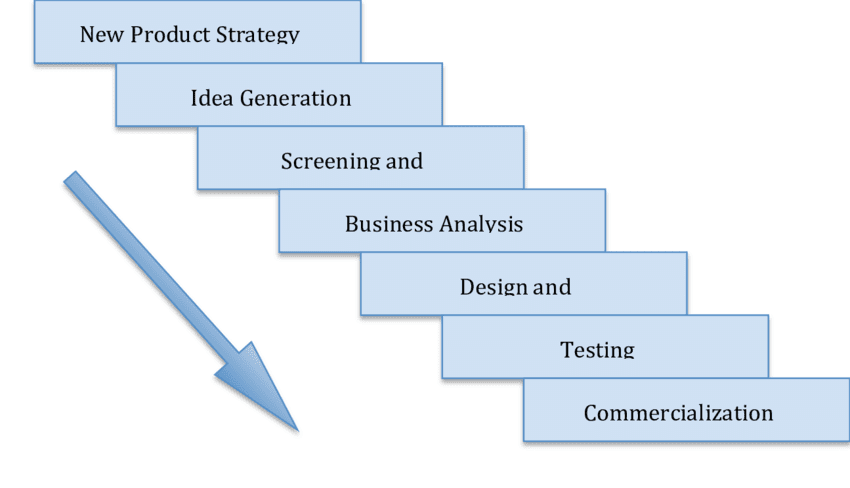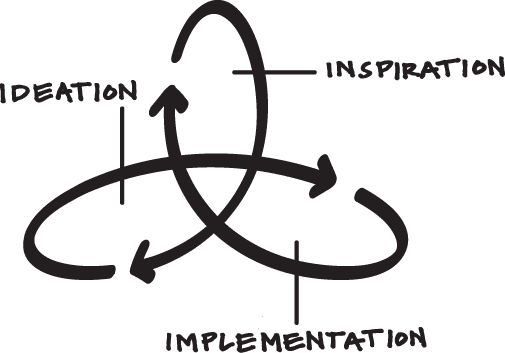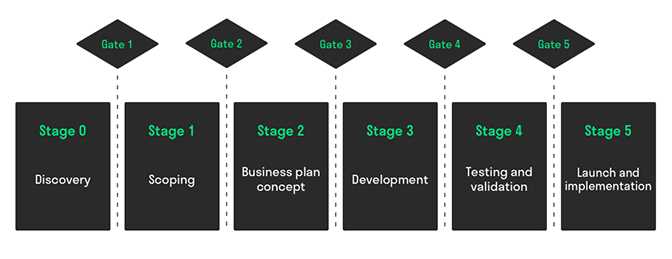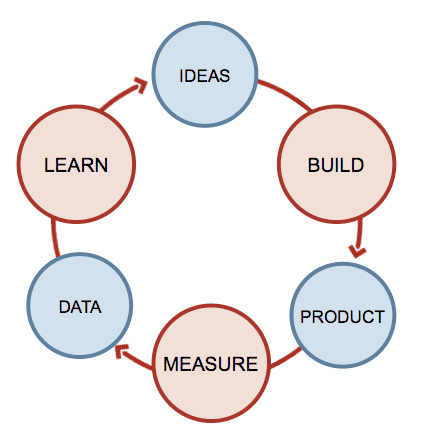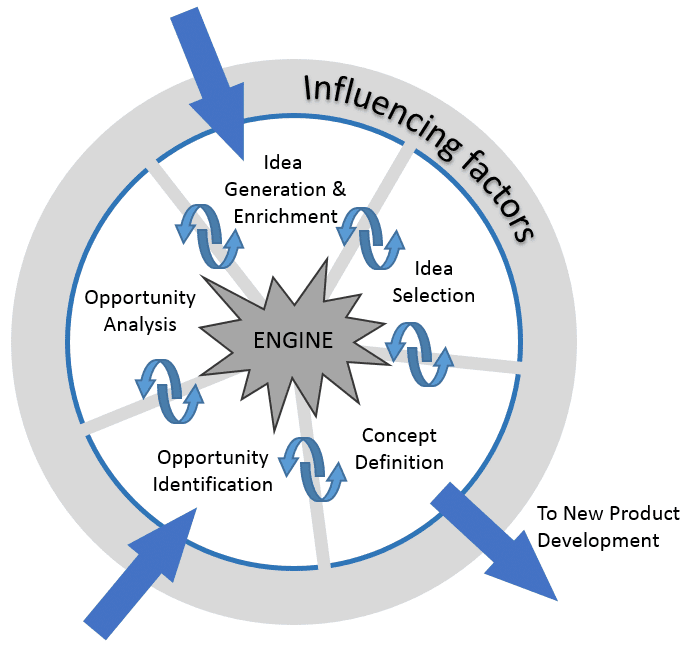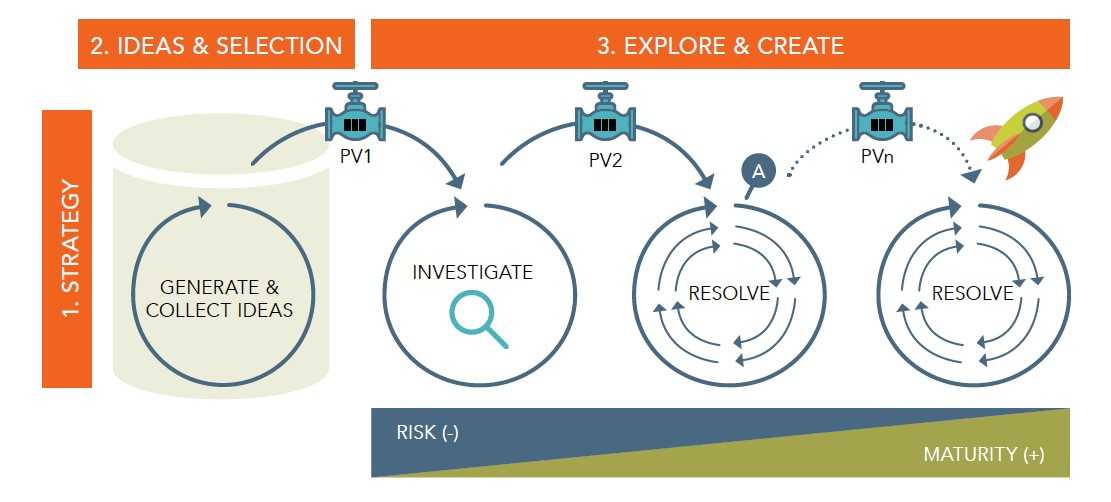New Product Development Methods
Quick Overview
In this article, I provide a summary of some of the formalised approaches to product development.
This information is useful for:
- first-time product developers wondering what approaches are available to learn about
- experienced product creators looking for a handy quick reference
Approaches Covered
The following approaches to product development are covered in this summary:
- BAH New Products Management
- IDEO Design Thinking
- Stage-Gate
- Customer Development
- Lean Startup
- New Concept Development
- Exploratory Product Development
BAH New Products Management
The first approach we look at is BAH New Products Management[2]. This is an approach that came out of work in the 1980s by a US management consulting firm named Booz Allen Hamilton.
It is regarded as one of the first models of product development to be published and is the basis of many other models that have been developed afterwards.
BAH New products management was a response to dealing with the inherent risk associated with new product development by following a systematic framework. The process runs the following seven stages in sequence.
New Product Strategy Development
First, the leader(s) of the product development project reviews the mission and objectives of the business. Then, roles are identified that a new product might play in satisfying the goals of the organisation.
The idea of this first step is to provide guidance for which direction to head toward with the new product.
For example, a business that specialises in, say, the hair-fashion industry, might look at its current goals of targeting consumers of online video content. It might then use this understanding as a framework for setting a strategy of which types of product ideas to consider, and which ones to set aside.
Idea Generation
A search is undertaken for product ideas that are compatible with the goals and objectives of the first stage. There is reflection on what product categories are of interest.
The main activity is then soliciting ideas from any potential source including employees, customers, vendors, connections, etc.
Screening And Evaluation
Ideas are screened to determine which discoveries should be further investigated. The aim is to narrow the list down to only those that have the greatest potential.
Business Analysis
The most promising product ideas are put through intense scrutiny to determine their potential for viability. Areas investigated include product attributes, barriers to entry, current and potential competitors, target markets, market growth information, financial projections, promotional methods, etc.
Development
The idea that has come out on top from the previous stages is translated into an actual product offering. This stages sees development of the actual product with numerous alterations and fine-tuning on the way.
Testing
Product testing is undertaken to validate earlier assumptions and hypotheses. Trials are undertaken to determine market suitability. In this stage, the goal is to connect with potential real customers where possible.
Commercialization
The final stage in the BAH approach is the full-scale introduction of the newly developed product to the market. During this stage, ongoing customer feedback is sought to ensure expectations are met, bugs are identified, competitor reactions are monitored, etc.
IDEO Design Thinking
IDEO is a design firm established in Palo Alto, California in 1991. IDEO was formed as a merger of several existing firms founded by well-known designers David Kelley, Bill Moggridge and Mike Nuttall.3
IDEO started out designing consumer products (e.g., toothbrushes, personal assistants, computers). Some of the more well-known products worked on by the IDEO folks include the first Apple Mouse the Palm V personal digital assistant and the Steelcase Leap office chair. IDEO has since expanded to be a major leader in the world of innovation, human-centered design and consumer experience.
The foundation of IDEO's success is a concept known as Design Thinking.
While Design Thinking wasn't invented by IDEO, they were ones to popularise it due to their success using it as a foundation for their own product development work. IDEO sees Design Thinking as a set of both mindsets and design-based activities that foster the collaboration required to solve problems in human-centered ways.
Here are a few quotes on how some IDEO folks describe Design Thinking
"Design thinking is a human-centered approach to innovation that draws from the designer’s toolkit to integrate the needs of people, the possibilities of technology, and the requirements for business success." (Tim Brown, CEO of IDEO)
"Design thinking is a process for creative problem solving. (Coe Leta Stafford, Managing Director, IDEO U)
The IDEO Approach
The design thinking approach is based on three core activities: inspiration, ideation and implementation .3
Inspiration
Frame a Question
Identify a driving question that inspires others to search for creative solutions.
Gather Inspiration
Inspire new thinking by discovering what people really need.
Ideation
Generate Ideas
Push past obvious solutions to get to breakthrough ideas.
Implementation
Make Ideas Tangible
Build rough prototypes to learn how to make ideas better.
Test To Learn
Refine ideas by gathering feedback and experimenting forward.
Stage-Gate Systems
Robert G. Cooper first published his ideas about stage-gate systems in 1990.5 Cooper describes stage-gate systems as "effective tools to manage, direct, and control their product-innovation efforts".
Cooper states that a stage-gate system is "both a conceptual and an operational model for moving a new product from idea to launch. It is a blueprint for managing the new product process to improve effectiveness and efficiency".
The system is made up of a number of stages, which are connected to each other by gates.
Work is undertaken in a stage.
In order to proceed through to the next stage, certain criteria need to be met at the current gate.
If the project fails to meet the criteria at the gate, a decision is made to stop developing further.
Stage 0: Discovery and Idea Generation
The process is initiated by a new product idea. It involves:
- Seeking new technological possibilities
- Working with innovative customers to uncover unarticulated needs
- Using creativity methods such as brainstorming
- Running strategic planning exercises to uncover gaps, opportunities and potential disruptions in the marketplace
Gate 1: Initial Screen
This is when the first decision is made to commit resources to the project to developing a product.
Gentle checks are made against criteria such as strategic alignment, project feasibility, magnitude of the opportunity, differential advantage, synergy with the firm's core business, available resources, and market attractiveness.
Stage 1: Scoping
A quick investigation and scoping of the project. Market and technical information is gathered at low cost and in a short time.
Gate 2: Second Screen
This gate is essentially a repeat of Gate 1: The project is re-evaluated, but in the light of the new information from stage 1.
Stage 2: Build the Business Case
A much more detailed investigation involving both market and technical research. This is where the bulk of the vital homework is done, which results in a business case to verify the attractiveness of the project.
Gate 3: Decision on the Business Case
This is the final gate prior to the development stage, the last point at which the project can be killed before entering heavy spending. Checks are made that the stage 2 activities were undertaken, the quality of execution was sound, and the results were positive. A detailed financial analysis is also undertaken.
Stage 3: Development
The detailed design and development of the new product, along with some product testing work. The deliverable at the end of Stage 3 is an alpha‐tested product. Full production and market launch plans are also developed in this potentially lengthy stage.
Gate 4: Post-Development Review
A check is made on the progress and the continued attractiveness of the product and project.
Stage 4: Testing and Validation
This stage involves tests or trials in the marketplace, and in-house to validate the proposed new product, and its marketing and production or operations.
Gate 5: Pre-Launch Decision
This gate focuses on the quality of the activities at the Validation Stage and their results. Financial projections play a key role in the decision to move ahead. Finally, the operations and marketing plans are reviewed and approved for implementation.
Stage 5: Launch
Commercialization begins in this stage. It is the start of full operations for production, marketing, and selling.
Customer Development
Customer Development is a model for building startups. It was developed by Silicon Valley entrepreneur Steve Blank in the 1990s.6
The customer development method is made up of four steps that help founders to establish repeatable and scalable businesses.
Customer Discovery
Customer discovery focuses on forming hypotheses and understanding customer problems and needs. Hypotheses are then tested by seeing whether there are actual customers that are willing to purchase.
Customer Validation
The customer validation step involves developing a business sales model that can be replicated and scaled. This step proves that you have a product and a market for it and that that customers actually make a purchase.
Check and Pivot
Founders can iterate and pivot back and forth between step one and two numerous times until a viable option is found.
Customer Creation
This marks the start of execution. In this step the goal is to create and drive end user demand to scale sales.
Company Building
Lastly, company building transitions the organization from one designed for learning and discovery to one focused on efficient operations and execution.
Lean Startup
Lean Startup is an approach developed by entrepreneur Eric Ries for developing businesses and products with an emphasis on short product development cycles and rapid assessment of viability.
The approach combines experimentation, driven by ideas and hypotheses, with iterative product releases and validated learning.
Build Measure Learn
The core concept of action in the Lean Startup approach is the build, measure, learn.
The goal is is to progress through a loop involving
- Generating an idea
- Building a minimum viable product as quickly as possible
- Measure its effectiveness in the market
- Learn from experience and results.
It has been described as a learning cycle of turning ideas into products, measuring customers' reactions and behaviours against built products, and then deciding whether to persevere or pivot the idea.
The lean startup approach applies the following key concepts:
Minimum Viable Product
A version of a new product which allows a team to test ideas and hypotheses with actual customers.
Continuous Deployment
Originating in the world of software products, continuous deployment is the approach of putting changes and updates to a product into production immediately. This enables actual use by customers and rapid verification of assumptions of value.
Split Testing
Running experiments to see which versions of a product provide the most value and impact on return to the business.
Actionable Metrics
Gathering data and statistics about the product and operations that can be used to make informed business decisions and subsequent action. Not gathering data which would be considered 'vanity metrics'.
Pivot
Changing strategy and correcting course of the business following learning from information gathered in production.
Innovation Accounting
Maintaining accountability and outcomes by measuring progress, planning milestones and prioritising.
New Concept Development
A 2016 study by Peter Koen (et. al), titled "Providing Clarity and A Common Language to the Fuzzy Front End" looked at the messy "getting started" period of new product development processes.7
In the study, Koen defined a New Concept Development (NCD) model consisting of a framework, as well as a set of terms to try and provide clarity to the fuzzy front end.
The NCD provides a model of the Front End of Innovation (FEI) and consists of three parts:
- Five Key elements
- Engine
- Influencing Factors
As stated by Koen, "the circular shape of the NCD is meant to suggest that ideas are expected to flow and iterate between all the five elements."
Five Key Elements
1. Opportunity Identification
The people involved identify the opportunities that the company might want to pursue.
2. Opportunity Analysis
Additional information is gathered to translate identified opportunities into specific business and technology opportunities. Early, often uncertain, market assessments are made.
3. Idea Genesis
This is the development and maturation of the opportunity into a concrete idea. It is a process where ideas are built upon, torn down, combined, reshaped, modified and upgraded.
4. Idea Selection
A choice is made regarding which ideas to pursue in order to achieve the most business value.
5. Concept and Technology Development
The final front-end step involves the development of a business case based on estimates of market potential, customer needs, investment requirements, competitor assessments, technology unknowns, and overall project risk.
Engine
The Engine in the model drives the front-end elements and is fuelled by the leadership and culture of the organisation.
Influencing Factors
The external environment which can affect the entire innovation process such as organisational capabilities, business strategy and the outside world.
Exploratory Product Development
Exploratory Product Development (ExPD) is an approach developed by Mary Drotar and Kathy Morrissey.8
In their words...
ExPD proposes a new approach to developing products, using a two-pronged solution: (1) treating product development from a comprehensive systems perspective, and (2) fundamentally redesigning the development process based on reducing project uncertainties and risk.
ExPD is a response to the issues observed with the more traditional phased-and-gated approaches to product development. The authors state that phased-and-gated projects must involve limited uncertainty and risk but this doesn't align well with the uncertain and changing world that we actually live in.
The ExPD process consists of three segments.
1. Strategy
The strategy segment runs throughout the entire process. Its purpose is to guide decision making in regards to about which products, markets, and technologies should be pursued.
In ExPD, there is a plan for adjusting the strategy dynamically based on external conditions encountered. The organisation remains flexible and adaptable through rapid learning and experimentation.
As stated by the authors of ExPD "strategy guides the selection of product development projects and it provides direction as the project evolves".
2. Ideas & Selection
In this segment, new product ideas are generated and collected. The best ideas are selected to pursue.
This segment "continuously looks across the business for multiple opportunities and new product ideas".
There are four key areas in this segment.
- ideas enter
- capture ideas
- prepare ideas
- prioritize
3. Explore & Create.
Throughout this segment focus is on creating a successful new product while attempting to reduce the risk of failure and improving time to market.
The authors state "explore & create involves identifying what outcomes would kill the project and where a potentially high level of risk will need to be managed. It then moves from Investigate to Resolve Loops where significant risks are addressed."
Avoid Large Batches to Gain Speed
Underpinning the ExPD approach is the technique gaining speed by breaking up the resolution of project uncertainties into small batches of activities.
Parting Thoughts
There you have it, a nice simple summary of some of the formalised approaches to new product development.
From here, you might like to read my related article: Where to Start When Developing a New Product.
References
[1]: https://www.wiley.com/en-us/Developing+Products+in+Half+the+Time
[2]: New products management for the 1980s. Booz, Allen & Hamilton. 1982.
[3] https://designthinking.ideo.com/
[4] http://dx.doi.org/10.3926/jiem.334
[5]: https://doi.org/10.1016/0007-6813(90)90040-I
[6]: https://steveblank.com/about/
[7]: https://doi.org/10.1080/08956308.2001.11671418
[8]: https://www.pdma.org/store/ViewProduct.aspx?ID=10930950

